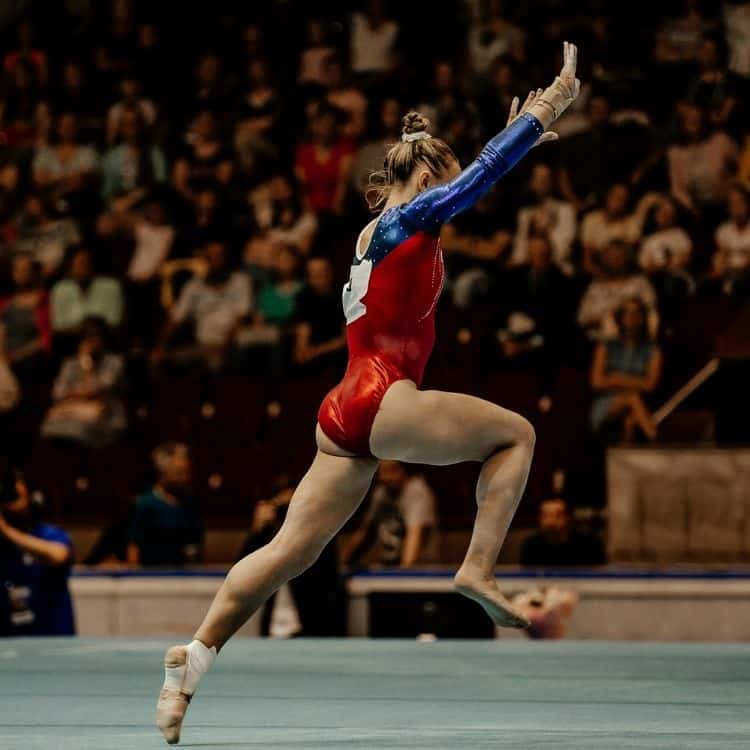
Have you ever wondered how to become an Olympic gymnast? It all comes down to intense, disciplined, and meticulously planned training that starts at a remarkably young age.
In this article we look at the training schedules, mental preparation and abilities needed to reach the very top of one of the toughest sports in the world.
Gymnasts Train Young
Gymnastics is one of the most watched and awe-inspiring Olympic sports. The artistry, precision, and seemingly gravity-defying skills that gymnasts demonstrate during their routines require years of training and dedication.
The training schedule for an Olympic gymnast begins years before they are old enough to compete at the Olympic level. Most future Olympians start learning gymnastics skills as a toddler or preschooler, stretching and tumbling as soon as they can walk and roll. It’s crucial to get an early start in the sport for a few key reasons.
First, younger children are naturally flexible and tend to more easily learn movements and motor patterns. Beginning training early allows time to build their skill level progressively as they grow.
Second, starting at a young age ingrains good technique during these formative years. Learning the proper form for skills is vital before increasing difficulty and amplitude.
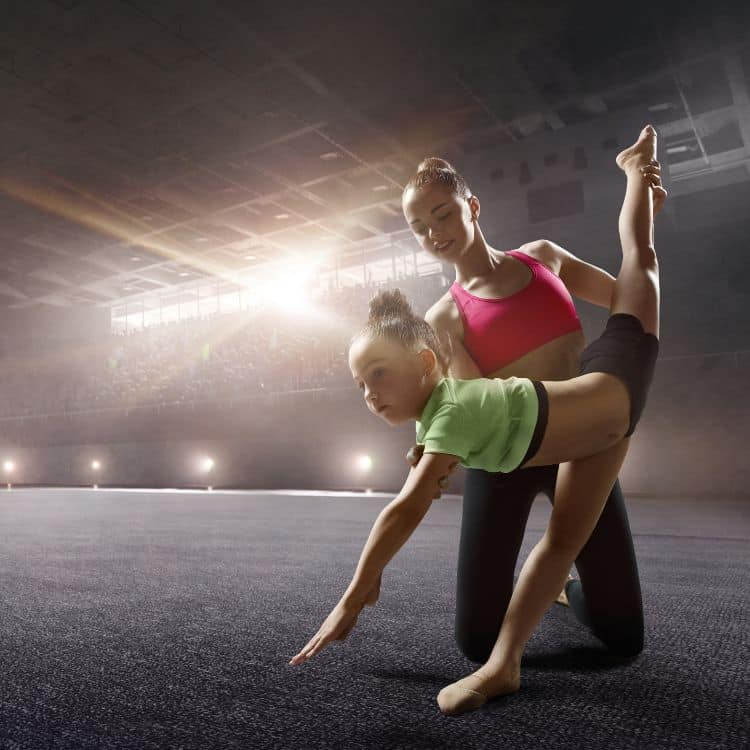
Thirdly gymnasts usually retire at a relatively young age in comparison to most other sports. By the time female gymnasts are in their early twenties, they have reached peak physical condition and for the men, mid to late twenties is a decent retirement age.
Finally, gymnastics requires a great deal of core, upper body and leg strength relative to body size and weight. Starting strength training young allows natural strength gains over time.
Serious training in a gym environment often begins around age 5 or 6. At this stage, the focus is on building overall fitness, coordination, balance, and learning foundational skills. Young gymnasts may spend 15-20 hours per week in the gym, rotating through work on different apparatuses and fundamental drills.
For example, they will work on basic bar skills like forward rolls, back hip circles, and casting handstands. Beam work involves mastering mounts and dismounts, balancing skills like scales, and simple tumbling like handstands. Floor exercise builds tumbling abilities through cartwheels, handstands, and front and back walkovers. Physical abilities are continually challenged as skills increase in difficulty.
Hone Technique as a Teen
By the teenage years, gymnasts devote 30-40 hours per week solely to gymnastics training. Tumbling, flexibility and strength work accelerate to prepare them for more complex skills. Now training intensifies on each individual apparatus as they develop the elite skills needed to compete nationally and internationally.
On uneven bars, gymnasts work towards release moves, pirouettes, and transitions between the high and low bars. Balance beam skills emphasize grace, flexibility, and precision as teens work on advanced balances like illusion turns and intricate acrobatic combinations.
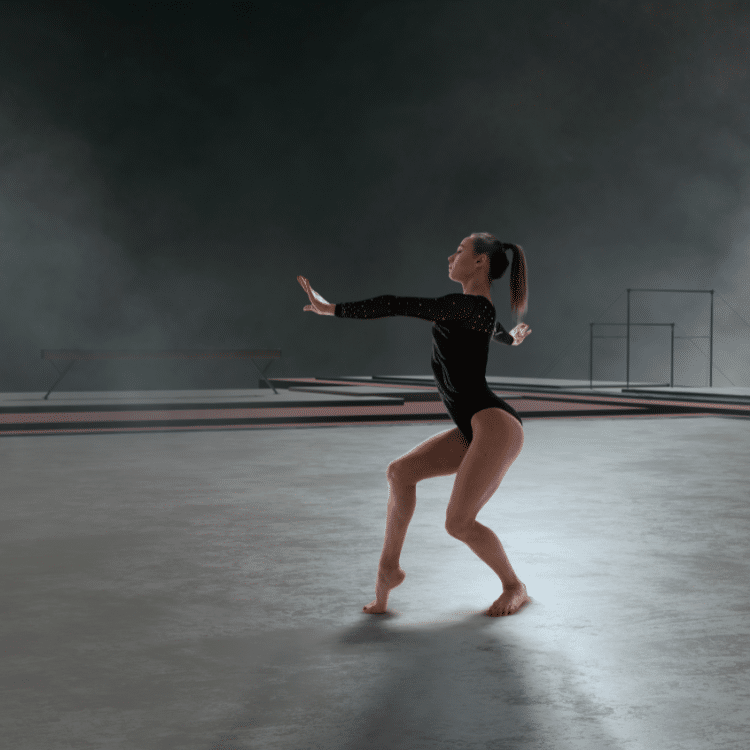
Floor exercise tumbling reaches new heights with powerful tumbling passes that may incorporate multiple back handsprings into full twisting layouts. Their proficiency and difficulty on vault also increase as they perfect their approach and implement more challenging entries like round offs and handsprings.
This training demands immense precision and repetition. Coaches break down even the smallest details of the technique. Gymnasts will drill skills over and over until they can be executed perfectly. Core strength and the upper body and shoulder muscles are honed through weight training and conditioning programs tailored to their needs.
Proper nutrition ensures they get enough calories and protein to support their rapid growth and intensive training demands.
Olympic Gymnasts Mental Preparation
In addition to the physical rigor, mental preparation begins to play a huge role as teens are expected to perform under significant pressure at competitions. Elite gymnasts work with sports psychologists on anxiety management, visualization, and mindfulness techniques. Staying mentally sharp yet calm during the biggest meets helps them nail routines when it matters most.
How Often Do Olympic Gymnasts Train?
In the year or two leading up to the Olympics, training intensity skyrockets. The gymnasts vying for a spot on their country’s Olympic team will train up to 40 hours per week, sometimes more. Their weekly schedule is grueling.
A typical intensive training week for a female artistic gymnast may look like:
- Monday – 5 hours of general skills work, strength training, and ballet. They use this day to recover from the past week while working on foundational abilities.
- Tuesday – 7 hours spent drilling uneven bars skills and routines. Bars requires tremendous grip strength and shoulder mobility, so gymnasts will repeat transitions and releases until they are consistent. They’ll also work on dance-like ballet movements for grace. Time is spent on cardio machines like the elliptical to build stamina. Stretching keeps muscles long and flexible.
- Wednesday – 5 hours working on new dance moves and choreographing how to integrate them smoothly into floor exercise routines. Gymnasts also meet with sports psychologists for mental preparation. Visualization, meditation, and positive self-talk help gymnasts stay focused under pressure.
- Thursday – 8 hours training on uneven bars again, followed by intense vault drills. Coaches perfect even the smallest technical details, like arm position during handsprings onto the vault. More dance training integrates new choreography. Cardio like running or cycling develops cardiovascular endurance.
- Friday – 6 hours dedicated to balance beam work, especially on combinations that require immense concentration and precision. Then floor exercise skills like tumbling passes are drilled for height and control. Weight training maintains muscle and bone density that supports dynamic skills.
- Saturday – 7 hours of performing full routines on each apparatus in a simulated competition setting. This tests their skills under pressure and helps prepare them mentally and physically for competitions. Coaches take notes on areas needing more work.
- Sunday – Active recovery like walking, stretching, massage, provides a break without losing fitness.
The week revolves around splitting time between the apparatuses while also developing stamina, flexibility, strength, and artistry. Gymnasts must quickly correct any flaws spotted by coaches given the short timeline between competitions.
Every skill and routine must be polished to the highest level of readiness. Gymnasts continue to push themselves technically and physically, preparing new upgrades to add bonus difficulty. Turns, leaps, and tumbling passes are executed with picture-perfect form. Their mental game must also be competition-ready, as they simulate high-pressure meets during training.
College Gymnasts Training Hours
The major difference between College gymnasts and those on the Olympic pathway is the limit on the number of hours that college gymnasts can train.
This limit is set by the National Collegiate Athletic Association (NCAA), which regulates college athletics in the United States. According to NCAA rules, college gymnasts are limited to 20 hours of training and competition per week during the season and 8 hours per week during the off-season.
These limits are in place to ensure that student-athletes have adequate time for their academic pursuits and to prevent over training and burnout.
Whilst College gymnasts may train less than those aiming to make the Olympic team, the demands are still high and exhaustion is not uncommon.
Development Level Training Hours
Women’s Artistic Gymnastics uses a 10 level Development program that enables young gymnasts to progress and compete at the appropriate level. If you are wondering how often a gymnast should train at a particular level, the information below will serve as a guide.
However, bear in mind that these figures will vary between clubs and coaches so they should be used as a guide.
| Levels 1 and 2 | 2 to 3 hours per week |
| Level 3 | 6 to 10 hours per week |
| Levels 4 and 5 | 9 to 14 hours per week |
| Levels 6 to 8 | 12 to 20 hours per week |
| Levels 9 and 10 | 18 to 25 hours per week |
Most Level 10 gymnasts in the USA are typically between the ages of 14 and 18. Level 10 is the highest level in the Development Program for Women’s Artistic Gymnastics in the USA and requires great dedication.
At this level, gymnasts are typically highly skilled and have been training for many years.
The number of hours that a Level 10 gymnast trains each week can vary greatly depending on several factors, such as their age, individual goals, and the demands of their gymnastics program.
However, it’s not uncommon for Level 10 gymnasts to train for 20 hours or more per week.
Levels 6 Gymnast Training Hours
Most Level 6 gymnasts in the USA are typically between the ages of 9 and 12. Level 6 is an optional level in the Development Program in the USA meaning gymnasts are able to choreograph their own routines rather than follow set sequences.
At this level, gymnasts are learning skills like Handspring Vaults and Back Tucks on the Floor.
It’s not uncommon for Level 6 gymnasts to train for 8 to 12 hours per week.
It’s important to note that gymnastics at this level is still demanding and requires a significant amount of physical and mental focus.
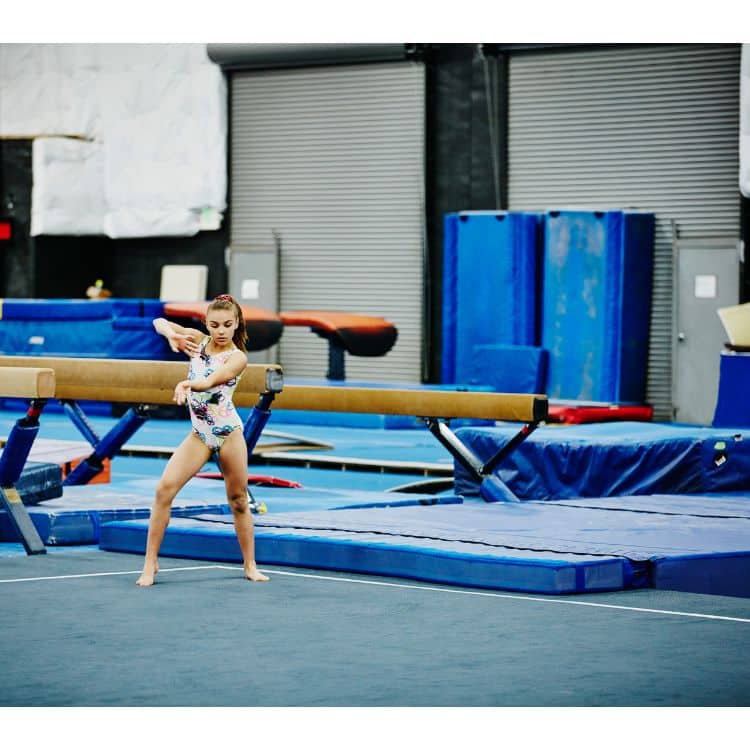
However, the training schedule is typically less intense than at higher levels, and gymnasts at this level are still developing their skills and abilities. Gymnasts at this level need to find a balance between their training and other aspects of their life, such as school, family, and other activities.
Level 2 Gymnast Training Hours
Level 2 gymnasts are typically between the ages of 5 and 7. Level 2 is Pre Team stage in the Development Program in the USA and is considered to be an introductory level of gymnastics. At this level, gymnasts learn basic skills and develop coordination, balance, and strength.
It’s not uncommon for Level 2 gymnasts to train for 2 to 3 hours per week.
Rhythmic Gymnast Training Hours
As with Artistic gymnastics, there are many factors that affect the number of training hours a gymnast can dedicate each week. Rhythmic gymnastics is an Olympic discipline therefore the potential rewards of medal glory make this discipline highly competitive.
Rhythmic gymnasts can typically train for 15 to 30 hours or more per week. Elite rhythmic gymnasts may even train for 40 hours or more per week.
This gives enough time to work on flexibility which is of huge importance in Rhythmic as well as choreographing routines using either the ball, hoop or ribbon.

Rhythmic may not use any big apparatus or require lots of tumbling but the demands are still intense!
Acrobatic Gymnast Training Hours
Acro gymnasts typically train for several hours each week, depending on their skill level, age, and competition schedule. Some gymnasts may train for as few as 6 hours a week, while others may train for up to 20 hours or more.

The exact amount of training time varies greatly, and many factors such as the gymnast’s goals, schedule, and physical abilities will determine their training regimen.
Acro (or acrobatics) isn’t an Olympic discipline yet but who knows what the future holds.
Tumbling Gymnast Training Hours
Tumbling involves lots of rebound and bouncing on wrists, ankles and knees, therefore, training sessions tend to be shorter than artistic gymnasts who can switch to different apparatus during the same session.
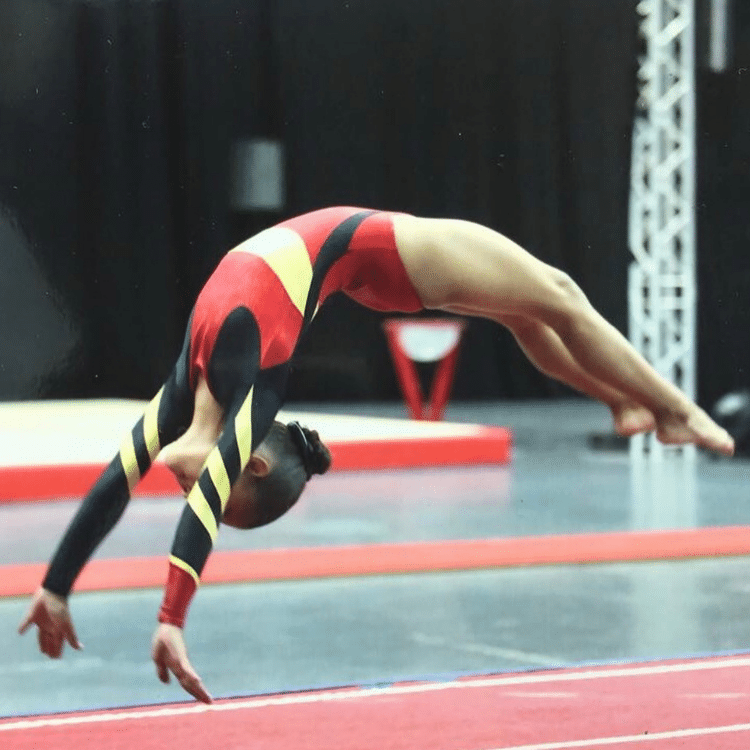
I’ve been fortunate enough to be in the same training sessions as former and future world champions and have learned from many great Tumbling coaches about how to plan the whole program.
Typically elite tumblers will train between 12 to 18 hours per week, though some may train less.
Injury Prevention for Gymnasts
To withstand their strenuous training, gymnasts must be extremely proactive about injury prevention. They diligently stretch and foam roll daily to maintain flexibility and joint health. Taping ankles, knees, and wrists helps stabilize those injury-prone joints during landings and skills.
Rest and recovery are also paramount. Gymnasts take scheduled rest days and integrate lower-impact cardio like swimming to stay fit while giving their bodies a break. Massage therapy helps their muscles recover faster. Proper nutrition provides fuel and nutrients needed for tissue repair.
Yet despite their best efforts, injuries still happen in this physically grueling sport. When injured, gymnasts work closely with athletic trainers and physical therapists to rehabilitate any strained muscles or damaged ligaments.
Smaller injuries may involve short rest periods and modified training. More severe injuries can require months of intense therapy and training modifications to enable a safe return to competition readiness.
The Road to Olympic Gymnastics
Earning a coveted spot on an Olympic gymnastics team requires immense dedication over many years. While their childhood friends enjoy summer vacations and school activities, these elite athletes devote nearly all their free time to training.
The perfection required at the Olympic level is unbelievable, as a single step out of bounds or a slight wobble could destroy medal dreams. It’s no surprise Olympic gymnasts retire at a remarkably young age considering the extreme toll this training takes on their still-growing bodies.
Yet the pursuit of Olympic glory continues to motivate a new generation of young gymnasts each cycle. Female gymnasts typically peak in their late teens to early twenties when they can combine petite, flexible physiques with mastered skills acquired from years of diligent training.
Male gymnasts generally reach their prime in their early to mid 20s as they gain additional strength and experience to achieve their most difficult skills and routines. All Olympic gymnasts should be applauded for their immense dedication, discipline, and sacrifice required to reach the pinnacle of their beautiful sport.
How do gymnasts not get dizzy during their routines? Gymnastics requires a lot of spinning, flipping, and twisting, which would make most people dizzy beyond control!
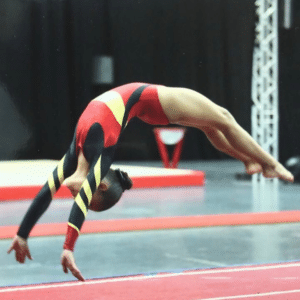
How Do Gymnasts Not Get Dizzy?
First, let’s take a closer look at why gymnasts might feel dizzy during their training. Dizziness is caused by a disruption of the vestibular system, which is responsible for balance and spatial orientation.
When the body spins or moves quickly, the fluid in the inner ear can become disoriented, leading to feelings of dizziness, nausea, and disorientation.
Techniques for Avoiding Dizziness
Gymnasts have developed a variety of techniques to avoid dizziness during their routines. Here are some of the most common techniques:
1. Spotting
Spotting is a technique used by gymnasts during spins and turns. It involves fixing the eyes on a specific point and then whipping the head around quickly to bring the eyes back to that point. This helps the brain to stay oriented and can reduce feelings of dizziness. Figure skaters and dancers also use spotting techniques when spinning and rotating.
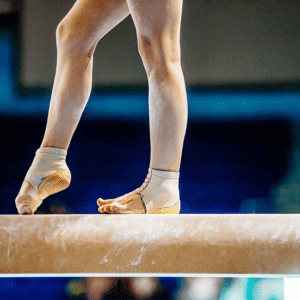
2. Mental Preparation
Gymnasts also use mental preparation to avoid dizziness. They visualize their routines and practice them in their minds, which can help the brain to adjust to the movements and reduce feelings of disorientation.
3. Practice and Repeat
Building endurance is another important strategy for avoiding dizziness. By practicing the same skills over and over again gymnasts become adjusted and dizziness decreases. Gymnasts train their bodies to handle the intense movements and forces of their routines, which can help to reduce feelings of dizziness.
4. Controlled Breathing
Controlled breathing is another technique used by gymnasts to avoid dizziness. By controlling their breathing and staying relaxed, gymnasts can help to reduce feelings of dizziness and maintain their focus during their routines.
Other Factors That Contribute to Dizziness
It’s also important to note that other factors can contribute to dizziness during gymnastics routines. For example, dehydration, fatigue, and stress can all increase the likelihood of feeling dizzy. That’s why gymnasts also pay close attention to their physical and mental health and work to stay hydrated, well-rested, and focused.
Final Thoughts
In summary, knowing how do gymnasts train requires immense sacrifices, discipline, determination, and perseverance starting from a remarkably young age. These athletes spend most of their childhood and adolescence training well over 30 hours a week to hone their skills on various apparatuses.
Their training schedule ramps up even further in the year preceding the Olympics, as they put their bodies and minds through the rigors of 6-7 hour practices six days a week. Every minute detail must be drilled to perfection.
While intense, their meticulous preparation allows Olympic gymnasts to demonstrate the pinnacle of athleticism, artistry, and human potential on the world’s biggest stage.
FAQs
Is there an age limit for Olympic gymnastics?
The minimum age for a gymnast to take part in the Olympics is 16 years old. If a gymnast turns 16 in the year of the competition this also counts being old enough.
How do you get to the Olympics for gymnastics?
Teams are qualified through World Championship results and individuals can also qualify through World or Continental Championships. This is relevant for high performing gymnasts who might represent a country which doesn’t have a strong team presence.
How do you become a pro gymnast?
To become a pro gymnast you will usually progress through the 10 Level Development Program and then enter the elite levels. For most gymnasts this means training from an early age and dedicating much of their childhood to training.
Is gymnastics a Summer Olympic sport?
Gymnastics is a Summer Olympic sport and has been since 1896. However, there are different types of gymnastics and not all are in the Olympics. Women’s Artistic was added in 1928, Rhythmic gymnastics was added to the Olympics in the 1984 and lastly Trampoline has been included since 2000. Tumbling made brief appearance as an Olympic discipline in 1932 but hasn’t returned since then.
- How To Get Over a Mental Block In Gymnastics: A Complete GuideGymnastics is a sport that requires not only physical strength and skill but also mental strength. When a gymnast feels like they cannot attempt a… Read more: How To Get Over a Mental Block In Gymnastics: A Complete Guide
- Find The Best Leotard For Girls (Guide)Finding an ideal leotard for girls isn’t just about picking a dazzling design that sparkles (although it does help!). The leotard has to fit perfectly,… Read more: Find The Best Leotard For Girls (Guide)
- The Best Gymnastics Shorts (Our Top Picks)The best gymnastics shorts are designed to be worn over the top of a leotard providing additional coverage around the upper legs, whilst allowing gymnasts… Read more: The Best Gymnastics Shorts (Our Top Picks)
- Decathlon Leotards – Are They Any Good?If you’re in the market for a new leotard, you may be wondering if Decathlon leotards are any good considering the low cost of their… Read more: Decathlon Leotards – Are They Any Good?
- A Complete Guide to Gymnastics Hand RipsAre you tired of dealing with painful gymnastics rips on your hands from training? Look no further – this article offers a comprehensive approach to… Read more: A Complete Guide to Gymnastics Hand Rips
- Is Gymnastics Dangerous? (Facts and Comparisons)Gymnastics is acknowledged as a highly technical and physically demanding sport. It inherently carries a risk of injury, which is why most coaches and clubs… Read more: Is Gymnastics Dangerous? (Facts and Comparisons)






